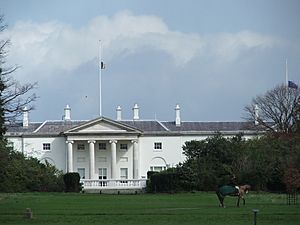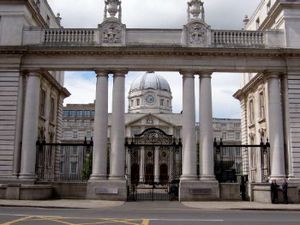Politics of the Republic of Ireland facts for kids
Ireland is a country in Europe that is a republic and a member of the European Union. It has a special way of governing itself called a parliamentary system. This means that the people vote for leaders who then choose the government.
The country has a President who is the head of state. This is mostly a ceremonial job, like a national symbol. The real power is with the Taoiseach (pronounced "Tee-shock"), who is the head of the government. The Taoiseach leads the country and its decisions.
The government is made up of a group of ministers, including the Taoiseach and the Tánaiste (pronounced "Taw-nish-ta"), who is the deputy leader. Laws are made by the Oireachtas, which is Ireland's parliament. It has two parts: Dáil Éireann (the main house) and Seanad Éireann (the Senate). The courts in Ireland are separate from the government and parliament, which means they can make fair decisions. The top judge is called the Chief Justice.
For many years, two main political parties, Fianna Fáil and Fine Gael, have been the most powerful. They used to be rivals, but both are generally in the middle of the political spectrum. In 2011, there was a big change: Fine Gael became the largest party, and Fianna Fáil lost a lot of support.
Contents
Ireland's Constitution
Ireland is governed by its own rulebook called the Constitution of Ireland. It was approved by the people in 1937. This Constitution explains how the government works and protects important rights for everyone.
The Constitution can only be changed if the people vote for it in a special election called a referendum. Over the years, people have voted on big topics like the role of the Catholic Church, divorce, joining the European Union, and same-sex marriage.
The President of Ireland

The President of Ireland is the head of the country. While the President has some specific powers, their main role is to represent Ireland and act as a symbol for the nation.
To become President, a person must be an Irish citizen and at least 35 years old. The President is chosen by the people in a secret vote. They serve for seven years and can only be elected for two terms. If only one person is nominated, they automatically become President without a vote.
If the President cannot do their job, or if the position is empty, a group called the Presidential Commission takes over their duties.
How the Government Works
The main group that runs the country is called the Government. It has between 7 and 15 members. These include the Taoiseach (the prime minister), the Tánaiste (the deputy prime minister), and other ministers who lead different government departments.
The Taoiseach is chosen by Dáil Éireann (the main part of parliament) and then officially appointed by the President. The Taoiseach then picks the other ministers, who are also approved by the Dáil and appointed by the President. The Government must always have the support of Dáil Éireann. If they lose this support, the Taoiseach must either resign or ask the President to call a new general election.
Political Parties in Ireland
Many different political parties are part of the Dáil (parliament). Often, different parties work together to form a coalition government.
- Fine Gael is currently the largest party. It started after the Irish Civil War and is known for supporting business and being pro-European. They have been in government many times, including from 2011 until recently.
- Fianna Fáil is the second largest party. It was founded in 1927 and has a history of being a republican party. They have led the government for many years.
- Sinn Féin is the third largest party. This party has roots in Ireland's fight for independence. Today, they are a republican party that focuses on left-wing economic and social policies.
- The Labour Party is the fourth largest. It was started in 1912 and has strong links with trade unions. They have often been a smaller partner in coalition governments.
- Other parties like the Anti-Austerity Alliance–People Before Profit, Independents 4 Change, Social Democrats (Ireland), and Green Party (Ireland) also have members in the Dáil. There are also many independent politicians who are not part of any big party.
Ireland's Place in the World
Ireland's relationships with other countries are greatly shaped by being a member of the European Union. Its connections with the United States and the United Kingdom are also very important. Ireland is known for its policy of military neutrality, meaning it doesn't join military alliances like NATO.
This neutrality has allowed the Irish Defence Forces to play a big role in United Nations peacekeeping missions around the world since 1960. They have helped keep peace in places like Congo, Cyprus, and Lebanon.
Ireland is also a member of many international groups, including the United Nations, the World Health Organization, and the International Monetary Fund.
Northern Ireland and Irish Politics
Northern Ireland has always been a big part of Irish politics. The island of Ireland was divided in 1920, creating Northern Ireland (which is part of the United Kingdom) and what is now the Republic of Ireland.
This division led to a long period of conflict known as The Troubles. This involved nationalists (mostly Catholic) who wanted a united Ireland, and unionists (mostly Protestant) who wanted Northern Ireland to stay with the UK. There was discrimination against Catholics and republicans. The Troubles caused thousands of deaths and much violence.
To help solve the conflict, the Irish Government worked with the British Government to create the Good Friday Agreement in 1998. This agreement helped bring peace and set up ways for Northern Ireland to be governed fairly.
Working Together: North and South
The Belfast Agreement also created the North/South Ministerial Council. This council brings together ministers from the Republic of Ireland's Government and the Northern Ireland Executive. They work together on different issues that affect the whole island of Ireland, like health and education. This helps both parts of Ireland cooperate and build a better future.
Images for kids
See also
 In Spanish: Política de Irlanda para niños
In Spanish: Política de Irlanda para niños




